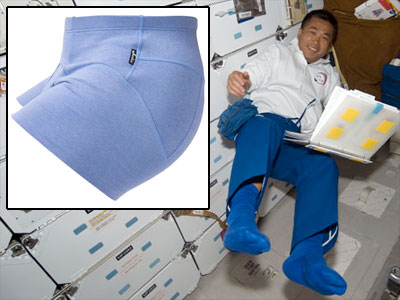[/caption]
Remember the “long duration underwear” tested out by Japanese astronaut Koichi Wakata on board the ISS last year? Now you can buy your very own. The specially designed undies and other clothing called “J-ware” are on sale now for 10,500 yen or about $115 USD. J-ware is treated with antibacterial and deodorizing materials, so they can be worn for long periods of and are resistant to odors. “(For) two months I was wearing these underwear and there was no smell and nobody complained,” said Wakata. “I think that new J-ware underwear is very good for myself and my colleagues.”
Hurry, sizes and quantities are limited.
Here’s the English translation of the J-ware website,
and the original Japanese version.
In addition to odor control, the clothes are designed to absorb water, insulate the body and dry quickly. They also are flame-resistant and anti-static.
Typically, clothes can only be worn for a few days in space, and especially the clothing worn by astronauts as they exercise. Since there’s no laundromat in space, the clothing is discarded as garbage.
Astronaut Takao Doi, who flew with a shuttle crew in early 2009 to deliver Japan’s Kibo laboratory to the station, exercised as much as his crewmates, but his clothes stayed dry.
Wakata’s clothes include long- and short-sleeved shirts, pants, shorts and underwear. Special socks have a separate pouch for the big toes (see top image) so the astronauts can use their feet like an extra pair of hands, helpful for anchoring themselves on the floor while doing work on the station.
Source: collectSPACE


“(For) two months I was wearing these underwear and there was no smell and nobody complained,” said Wakata.
Erm…. I hate to say it, but they were probably just being polite…
Are they antibacterial or Febreeze scented?
Boxers, briefs, or thongs?
Another great important space technology inflicted on humankind. The price of $US115 might seem a little high, but considering the cost of the R&D behind it, this is probably an absolute bargain!
think I’ll stick to my teflon coated frying pan
I don’t know, what these undies do weight. But I guess that it does not weight any more than standard ISS astronauts’ undies. I don’t know what standard ISS astronauts’ undies do cost. But I guess that they are not cheap at all. I do further suppose that it takes 10,000 Dollar to transfer 1 kilogram into orbit. The article claims that standard ISS astronauts’ undies are changed every few days, while these undies are changed every few month.So I conclude that this means saving by a factor of 30 with each deliverance of fresh undies to the ISS.
This technology is great under the constraints, but the US fad for everything “antibacterial” means that these may be bought for ordinary consumption which is the opposite of great. Besides the obvious problems with bacteria resistance which AFAIU have been observed for these treatment types of chemicals and should be confined to medicine and space, the typically chlorinated organics (I note that the ref’s doesn’t say) used aren’t environmentally friendly.
And who in a sane mind would like to go with chlorinated organics next to their bodies at length anyway? Most are eventually found to be carcinogenic, I believe.